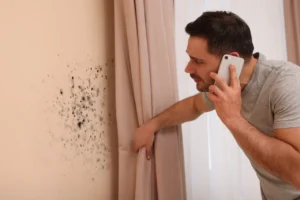Expert tips for securing your house or apartment
Key takeaways
-
Your home is most vulnerable when it looks as if nobody’s there
-
Strong doors and deadbolts are an important first line of defense
-
Video doorbells are an inexpensive and effective way to keep watch
The last thing any renter or homeowner wants is a break-in. Not only do you lose valuable belongings, but having personal space violated can make you feel vulnerable, long after the breach.
Fortunately, there are proven ways to keep your home safe and secure. With the advice of security experts, law enforcement officers, locksmiths—even a few burglars—we’ve compiled a checklist to help you thief-proof your residence.
Think like a burglar
First, it’s important to know how burglars operate. Consider this important lowdown on the criminal mind.
How crooks choose their targets
 In a 2019 investigative report, TV station KGW in Portland, Oregon, anonymously questioned convicted thieves about their break-in practices. Here’s what they learned:
In a 2019 investigative report, TV station KGW in Portland, Oregon, anonymously questioned convicted thieves about their break-in practices. Here’s what they learned:
-
Criminals will strike when they think you’re away. They’ll look for signs that you’re at work or on vacation.
-
That stranger at the door could be casing your place. Many burglars knock on the front door to make sure the coast is clear before breaking in. If someone answers, they may pretend to be lost or taking a survey, then get away as quickly as possible.
-
Leaving doors or windows unlocked is practically an invitation. That’s the preferred method of entry for most burglars (and the easiest to prevent).
-
Criminals go for the least troublesome target. In an apartment building with 10 units, they’ll choose the one that has the fewest security measures and seems easiest to enter.
Where thieves look
Most burglars want valuables that are easy to carry and convert to cash. In most cases, they’re looking for:
-
Jewelry
-
Electronics
-
Cash
-
Credit cards
-
Collectibles
-
Guns
-
Medications and drugs
Once inside, they’ll first hit easy targets, such as dresser drawers in the master bedroom. Then, they’ll search the rest of the house—including your “clever” hiding places. One crook said he’d look “from the stove and freezer to the fish tank and toilet tank, bookshelves, and [even] in boxes of cereal.”
Keeping valuables in a home safe will slow down most burglars, but make sure the box can’t be easily pried out of the wall or floor and carried away. Criminals will steal the whole safe, or portable lockbox, then remove the contents later.
Safes should be bolted to the floor, especially if there’s a level of concrete. (If there isn’t, try bolting it to floor studs.) Instructions on doing this may be included with your safe, or available from the place where you purchased it. If you don’t have the tools (such as a hammer drill) or experience to do this yourself, hire a trusted handyperson—one with good online reviews and an established reputation.
Top burglar deterrents
Homeowners often resort to all sorts of practices to deter or repel burglars, with mixed success.
Here some the top pro tips for keeping bad guys out:
-
Invest in good door locks. “These [burglars] know what they’re doing,” says second-generation locksmith Jay Sofer, owner of Lockbusters in New York City. “If they see a deadbolt on your door that’ll give them more grief, they’re not going to choose your [place].”
-
Let the big dogs bark. Many burglars avoid a place with a large, barking dog. “Dogs are a deal-breaker for me,” said one inmate in the KGW survey. “Big breeds—‘home protectors’—are the best to keep people out.” A smaller dog may not be a deterrent, but can alert you by barking if someone is skulking around outside or trying to enter your home.
-
Don’t count on that home-security sign. Some burglars may be put off by a sign warning of security protection. But they also know many of these are just decoys—the home might not actually have a security system installed.
-
Let the system itself scare them off. Alarm systems and security cameras can be a strong deterrent, especially if they’re installed in places where they can be seen but not easily disabled or stolen. (At the same time, extensive security measures can also be a signal to ambitious criminals that you’ve got valuables inside. So if you’re working with a home security company, ask what they recommend.)
-
Avoid the dark. Interior lights can help deter burglars, especially if they’re set on random timers that signal someone is home. So can bright outdoor security lighting, because criminals want to lurk in the shadows. (But an outside light with curtains shut tight is a welcome mat for thieves. One inmate in the KGW survey reportedly drove through upper-class neighborhoods looking for homes with lit porch lights and closed blinds.)
-
Make some noise. Consider putting your TV on a timer so it goes on at night (loud enough to be heard, but not so much that it bothers the neighbors). Most burglars questioned in the survey said they wouldn’t break in if they heard a TV or radio blaring inside the house.
Best ways to burglar-proof your home
Ready to fortify your house or apartment against intruders? Here are top steps to take.
Install deadbolts or high-security locks
 High-security locks are essential to keeping out unwanted visitors. Learn more about pick-proof, drill-resistant hardware in this eye-opening video with Jay Sofer of New York City-based Lockbusters.
High-security locks are essential to keeping out unwanted visitors. Learn more about pick-proof, drill-resistant hardware in this eye-opening video with Jay Sofer of New York City-based Lockbusters.
If you don’t already have deadbolts—which hold the door in place with a hard metal rod—hire a locksmith to add them to all of your exterior doors as a second level of protection. They’re a reliable way to improve a home’s security.
“The very low-hanging fruit for burglars? People who rely on a [door’s] automatic locking feature, and [just] pull the door shut,” Sofer says. In many cases, burglars can force that basic lock open by sliding a hard piece of plastic into the door, a method called “shimming.”
A deadbolt has to be installed correctly, so it slides solidly into the door frame (not just the door trim)—otherwise, the door can still be kicked in. Your best bet is to have them installed by a professional locksmith, at a cost of about $70–100 per door.
Even better, consider having your locksmith install pick- and drill-resistant high-security locks on exterior doors. These cost $135–270 per lock, plus labor charges of $120–200 each. (You can often save on labor costs by replacing multiple locks during the same visit.)
If you’ve recently moved into your home—or if there’s any possibility that an unauthorized person has access to a house key—be sure to have a locksmith rekey all the locks. (Of course, new residents should also reprogram the passcode on an existing home security system.)
Finally, don’t spoil all of these security measures by putting your spare key in a “secret” hiding spot outside the door—under a plant or doormat, for example. Burglars know how to find them.
Strengthen exterior doors
If force is necessary, thieves prefer kicking in a door to breaking glass, according to the KGW survey. “Loud bangs are better than loud glass breaking, plus you run the risk of getting cut,” one inmate said.
Bolster strike plates
Talk to your locksmith about reinforcing your front and back doors and frames so they can’t be kicked in. They can use extra-long screws to attach security strike plates and hinges, and rekey any existing locks if necessary. Expect to pay $100–300 per door.
Pro tip: You can DIY this fix with some elbow grease. Replace the existing strike plate (the piece of flat metal with a hole that the deadbolt slides through) with an elongated “reinforcement” strike plate, available in hardware stores and online. At the same time, replace the existing short screws that secure the strike plate to the door frame with 3½-inch screws (which are usually included). Total cost is under $35.
Consider pry-proof doors and frames
Regardless of how good your locks are, they won’t keep out a burglar if the door is weak. Burglars may be able to separate the lock from the door with a lot of force, using a pry bar or crowbar, Sofer says.
The strongest doors are 1¾-inch thick and made of steel, solid wood, or solid composite. The frame around the door must be equally strong and made of solid wood. A professional door installer or security door expert can help tell if yours are good enough.
Toughen glass
What if your exterior door has a window in it or next to it? Talk with a security-window specialist about your options, such as installing break-resistant security glass, or sensors that set off an alarm if the glass is cracked. (See “Secure windows,” below.)
Add a peephole
If you open your door to someone, a door chain doesn’t provide much protection—so be sure you have a $10–20 peephole or wide-angle viewer, or a doorbell camera that sends video to your cell phone, to see who’s there. “That’s your No. 1 line of defense if someone is at your door,” Sofer says.
Secure a sliding door
A sliding glass door is another vulnerable point of entry. Protect it with strong locks, as well as a $20 security bar that fits in the sliding channel (or separate locks that clamp onto it). A security pin can also provide some protection, but you have to remember to use it.
Some burglars may try to smash their way in through a patio door, especially if it’s in a secluded area. A security system that alerts you to the sound or vibrations of breaking glass can be useful. Or if you’re really concerned, consider installing shatterproof film on the door glass—DIY kits cost about $300 in home-improvement centers and online.
Don’t forget the garage
That’s another door to consider. Make sure the garage door locks securely, and opens with a hack-proof remote. (Most important, don’t leave a garage-door opener where a burglar could get to it—clipped to the visor of a car in the driveway, for example.)
If your garage can also be entered through a side door—or if it’s an attached garage with an inner door leading to your home—be sure both doors are strong and protected by secure deadbolts.
Secure the windows
Of course, burglars can break glass and enter through windows. A security-window specialist can install break-resistant security glass, or install glass-break sensors that trigger a security alarm. Be sure windows have secure locks, and that you use them.
Steel security bars can be another effective crime deterrent, according to HouseLogic, a publication of the National Association of Realtors. They’re especially useful on windows that are accessible at street level or from fire escapes. Just be sure they have a quick-release mechanism—located where an intruder can’t break the window and access it—so you can get out during a fire or other emergency. Bars for larger windows cost about $300–500, plus $100–200 for installation.
Window air-conditioning units are a common and vulnerable entry point, because they’re easy for burglars to force out, leaving an open space. If you have one or more window air conditioners, especially in first-floor windows, be sure they’re screwed or bolted securely to the framing so that removal is a serious chore.
Paying Too Much For Insurance?
Get a FREE quote to insure your rental properties for less.
Home security systems
Security cameras, alarms, and other gear are more affordable than ever. Here’s what you may need.
Buy a door alarm
If you live in a condo or apartment where the main point of access is the front door, a simple door alarm can help protect you when you’re home. One piece goes on the door frame, the other on the door; when the two parts are pulled apart by opening the door, a loud siren will sound.
A basic model, which doesn’t connect to a monitoring service or send an alert to your smartphone, relies on a loud sound to scare away a burglar. You can buy a two-pack online for less than $15.
Install a video doorbell
Video doorbells containing a microphone and camera allow you to see and talk to someone at the door from your smartphone. Ring doorbells, the best-known brand, cost about $60–350, depending on the features.
These devices can run on batteries or be connected to your old doorbell’s wiring; some models come with high-definition video, enhanced audio, and even night vision. They usually turn on when motion sensors detect someone outside the door; some can even tell if the motion is caused by a person, rather than a roaming pet.
Wireless video doorbells are designed for quick and easy DIY installation—just remove your old doorbell and replace it. Wired models, which can use the electric wiring from your original doorbell, may be more difficult. Some companies offer installation services; otherwise, you can hire an electrician. Installation generally costs $100–250.
Mount security cameras
Installing cameras at entry points—front and back doors, for example—can discourage burglars, because they can’t be sure if they’re being watched. Ideally, you should position cameras out of easy reach to avoid tampering or theft.
If you don’t want to pay for a complete system and monitoring by a security company, consider purchasing a simple, “smart” wireless outdoor camera. For as little as $45, you can buy one that connects to your home’s Wi-Fi network and be monitored from your smartphone. This is a great option for renters on a budget seeking peace of mind without loud alarms.
Invest in a home security system
One of the surest ways to make your home more secure is to invest in a reliable home security system. There are a wide variety of options available, from the latest DIY devices to professional companies that handle everything for a monthly fee.
Smart home security protects your home with a system of sensors, cameras, and alarms connected to a central hub that you can monitor on your phone, or pay to have professionally monitored. The system might also include smart locks, smart lights, and other devices.
To learn more about the latest home security devices, read Smart home security: Quick and easy home protection.
More home security tactics
Now that you’ve reinforced your home, here are some other important ways to prevent burglaries.
Shed some light
 Keep nighttime burglars away by making sure your house is well lit, inside and out. Security flood lights will produce a bright, wide beam that illuminates the entry, driveway, and landscaping, for about $300–400 installed.
Keep nighttime burglars away by making sure your house is well lit, inside and out. Security flood lights will produce a bright, wide beam that illuminates the entry, driveway, and landscaping, for about $300–400 installed.
Or consider bright spotlights with motion detectors that only turn on when they sense movement, Sofer recommends. This feature reduces energy waste and nighttime light pollution.
Well-installed lighting won’t cause excess light pollution or bother other families. To be sure, look for specially marked “Good Neighbor” lighting products from certain home-improvement stores, or a Fixture Seal of Approval from the International Dark-Sky Association (IDA). These labels certify that the lighting minimizes glare, spilling over into a neighbor’s yard or windows, or skyglow (the amount of artificial light that floods the sky at night).
To learn more about outdoor lighting, read 7 outdoor landscape lighting ideas for your home.
Put plants to work
Use your landscaping to create a defensive barrier, placing thorny or prickly plants, such as rose bushes or prickly hedges, beneath windows. A dense, sturdy hedge can also act as a barrier to keep intruders from climbing a wall or fence.
Meanwhile, consider pruning back less protective types of large shrubs near doors and windows. These could provide cover for a burglar lurking outside your home.
Hide valuables from clear view
Avoid placing expensive items, such as electronic gear or paintings, where they can be seen from windows. Curtains and shades can help hide your possessions, but keeping them all closed can be a sign to thieves that you’re not home.
Don’t advertise being away
Don’t mention travel plans, or post photos of a current trip, on social media—thieves see these announcements as invitations to an empty house. While you might trust your close friends and followers, you never know who could be viewing your posts.
When you’re away for more than one day, make sure your home continues to look occupied. Here are some steps to take:
-
Ask a dependable neighbor to collect any circulars, local papers, or packages that arrive in front of your house (and watch for any strange vehicles in your driveway).
-
Pause delivery of subscription newspapers and mail.
-
Arrange to have your lawn mowed or snow shoveled while you’re away.
-
Put lights, TV or radio on automatic timers that turn on and off in the evening.
Get to know your neighbors
Sometimes a watchful neighbor can deter a break-in. Plus, they’re more likely to notice strange vehicles or suspicious activity. If your area has a Neighborhood Watch program, consider getting involved.
Extra tip: Get theft insurance
What if you do experience a burglary? While it can’t replace treasured mementos and heirlooms, insurance can take the financial sting out of some losses. Contact your insurance company to purchase or check on coverage, and make sure you have what you need, whether you’re a homeowner or renter.
Discuss these categories:
-
Personal property coverage: This will help repair or replace belongings that were stolen or damaged.
-
Dwelling coverage: This will help repair damage to your house caused during a break-in.
-
“Other structures” coverage: This will help pay for repair of detached structures, such as a shed.
A standard homeowners or renters insurance policy almost always covers losses from break-ins, but know the limitations of your coverage. Pay special attention to these details:
-
Limits. Your standard policy may have relatively low coverage limits for theft—usually about $1,500, according to the Insurance Information Institute (III), an industry group. That can be a lot less than the cost of a high-value item. You can often buy additional “floater” coverage for specific valuables, which will need to be professionally appraised.
-
Deductibles. A deductible is your share of the cost for a covered claim. If you have a $500 deductible policy, you pay the first $500 in losses.
-
“Replacement cost” vs. “actual cash value.” Replacement cost coverage reimburses you for the cost of re-purchasing something at today’s prices. Actual cash value coverage, meanwhile, only pays what the stolen item could be sold for today, factoring in age and depreciation.
It’s important to inventory possessions to prove losses in case of theft. “Having an up-to-date home inventory will help you get your insurance claim settled faster, verify losses for your income tax return, and help you purchase the correct amount of insurance,” the III says. They recommend taking pictures or video-recording a walk-through of your home, including every valuable item.
Source: Yelp













 Accessibility
Accessibility